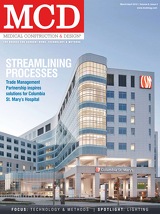Medical Construction & Design (MCD) is the industry's leading source for news and information and reaches all disciplines involved in the healthcare construction and design process. To view more past issues go to: http://mcdmag.epubxpress.com
Page 48 of 70
TECHNOLOGY & METHODS
industry is changing. The advent of Accountable Care Organizations, bundled care, telehealth,
telemedicine and other developments will change future healthcare delivery, and the facilities and technologies necessary for support. > Preparing for how technology is changing, and recognizing that a robust infrastructure is only a starting point. Key questions include: How is technology changing? Where can fl exibility be built into the infrastructure? What medical devices are planned for the project? Will new protocols, procedures or technologies in development today change the way healthcare is delivered in the foreseeable future? > Recognizing the project-delivery model matters in healthcare construction today. A collaborative planning process is now essential. A project-delivery model that requires all decisions be fi nal at the end of design before construction documents are developed without allowing hospitals to make changes required to adapt to changing technology is no longer realistic. With a properly established team covering all disciplines, successful project completion can be achieved using a variety of models including design- build, partnering and integrated project delivery.
REALIZING TRUE INTEROPERABILITY
More than merely connected and passing data, true interoperability requires confi guration of every medical technology to ensure the correct data is delivered to the appropriate clinician in the location that supports clinical workfl ow. Confi guring systems to support effi cient, effective and safe operations is the goal of a successful technology
Today, no technology stands alone. It's all connected: generating, sharing, trading and acting upon information.
implementation. Because all technologies in healthcare are interdependent, the line between owner-furnished and contractor- furnished systems and equipment is disappearing. Further breaking up responsibilities for planning, design and project management of medical technologies among multiple disciplines simply decreases effi ciency and adds to the likelihood that change orders will occur. A project developed in 4-D BIM struggles to adequately address technology integration. Although 4-D BIM is a helpful starting point, a multi-faceted approach to healthcare technology that goes beyond equipment and infrastructure planning to include comprehensive technology integration management is
44 Medical Construction & Design | March/April 2012
necessary to achieve true clinical interoperability.
Terry Miller, executive vice president at GBA, has more than 40 years of ex- perience in communications systems design and infrastructure planning for hospitals and healthcare systems. Miller is a frequent speaker and author of articles addressing communica- tions/technology planning issues.
Ted Hood, vice president and chief operating offi cer at GBA, has 12 years of experience as a technology planner with GBA and six years of prior archi- tectural experience. Hood's portfolio of work includes two years as an archi- tectural project manager specializing in healthcare design.
Cynthia Mercante, vice president at GBA, has 15 years of experience in systems analysis supporting health- care technology project management and procurement.
www.mcdmag.com
